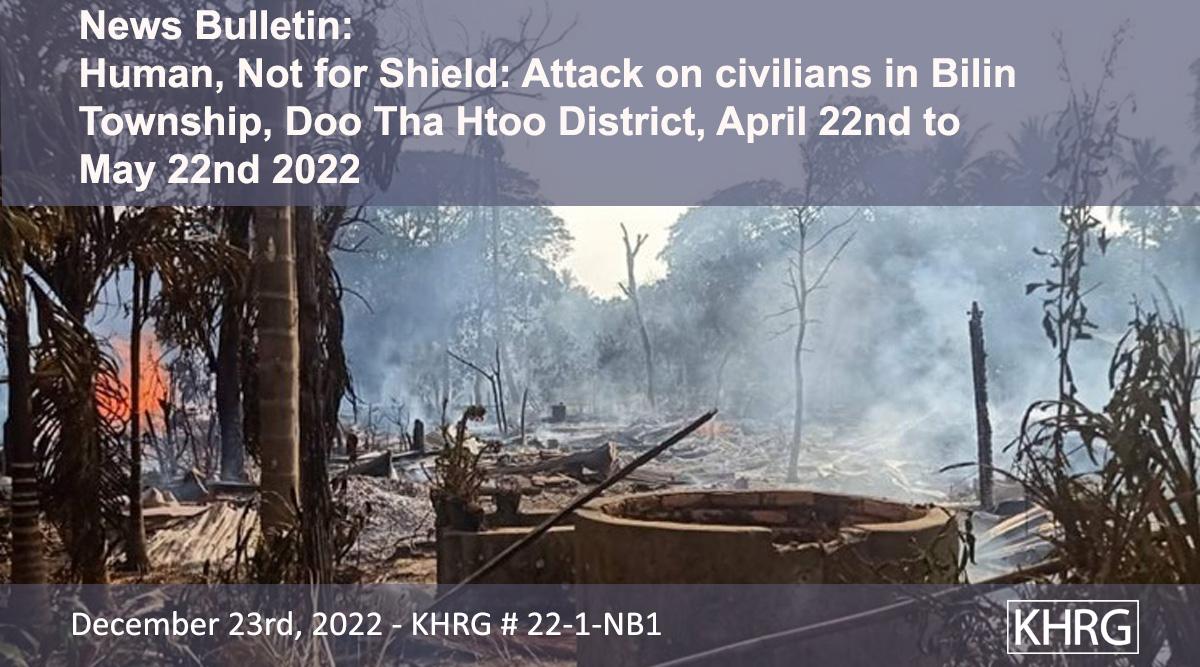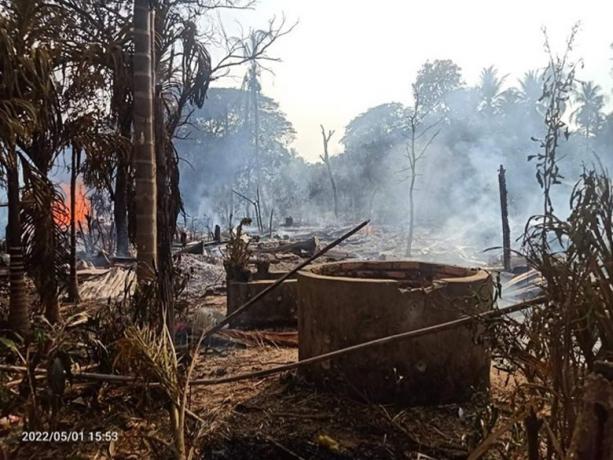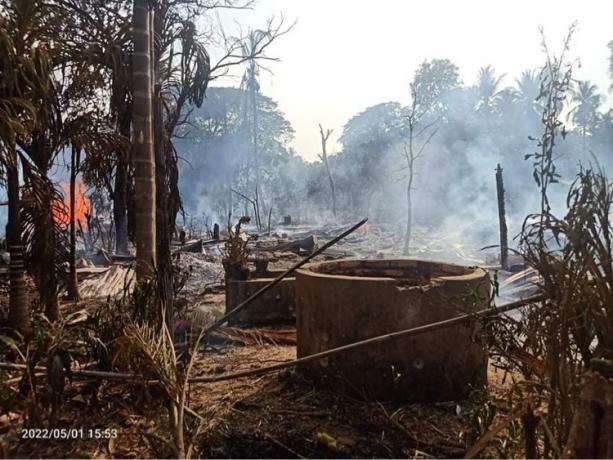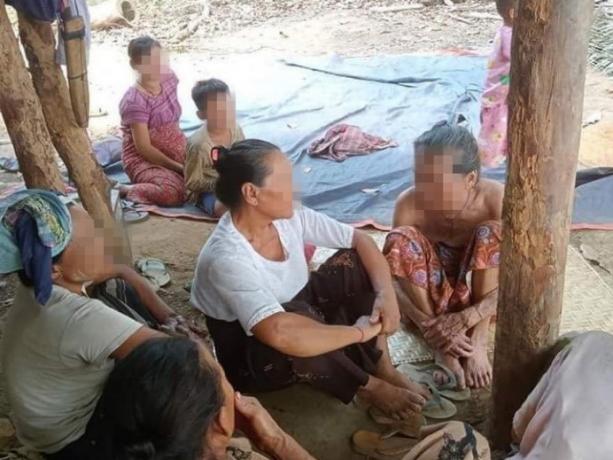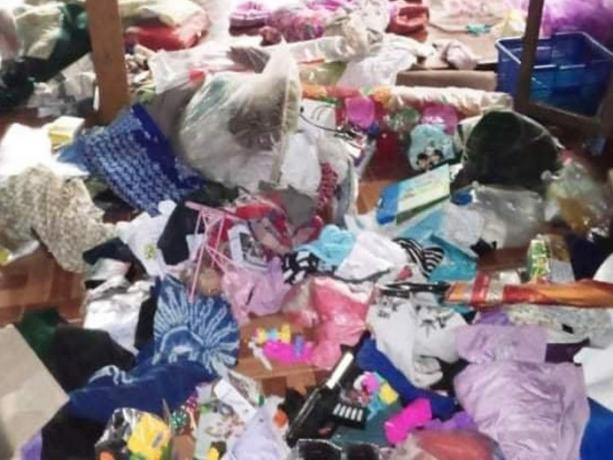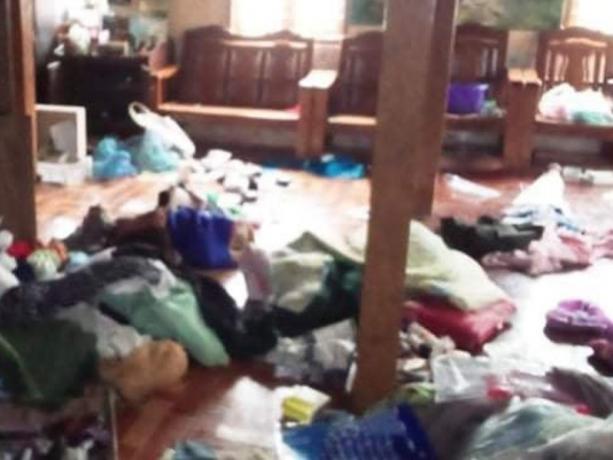Introduction
Following the February 2021 coup, villagers in Doo Tha Htoo (Thaton) District have faced a significant increase in the number of human rights violations committed against them due to the escalation of military activity and fighting between the Karen National Defence Organisation (KNDO)[1] and the combined forces of the State Administration Council (SAC)[2], [3] and Border Guard Force (BGF)[4]. Local villagers have not only been impacted by that activity, but have also been the target of many attacks. This news bulletin outlines a number of human rights violations that were committed in Doo Tha Htoo District between April 22nd and May 22nd 2022, following a statement that was released by the KNDO on April 20th 2022, urging SAC troops to withdraw from Lay Kay and Ta Paw army camps. Because of the failure to withdraw, fighting between the KNDO and joint forces of the SAC and BGF broke out in the area.
During the reporting period, local villagers have faced displacement, looting, property damage, forced return, and other threats by the SAC and BGF. Villagers have also been used as forced porters, navigators and human shields. On May 1st, Doo Tha Htoo District suffered from its first air strikes since the coup. Launched by SAC aircraft, these air strikes resulted in 59 houses being damaged and 10 houses being burned to the ground. Thousands of villagers have had to displace and have experienced a lack of essential supplies and humanitarian aid while at these displacement sites.
While the district saw a lapse in conflict and conflict-related human rights violations following the signing of the Nationwide Ceasefire Agreement (NCA)[5] in 2015, the current military junta has reinvigorated its ‘four cuts’ strategy[6]. The ‘four cuts’ strategy was first implemented in the mid-1970s in Karen State and led to widespread and systematic violence against villagers in Doo Tha Htoo District for several decades. Since the 2021 coup, villagers and their property have become the target of SAC attacks, making it impossible to remain in their villages amidst the damage and destruction. The incidents that are covered in this news bulletin show that grave crimes are being committed by the SAC and BGF, in breach of international humanitarian and human rights laws and norms, and that may amount to war crimes and crimes against humanity.
A. SAC and BGF refusal to withdraw
On April 20th 2022, concerned about the security of villagers, the KNDO in Bilin Township, Doo Tha Htoo District released a statement to try to get the SAC and BGF to leave local areas under Karen National Union (KNU)[7] control. The statement provided two options for the SAC and BGF from Lay Kay and Ta Paw army camps. The first option was for SAC and BGF troops to reunify with the KNDO before April 23rd 2022. The second option was for the SAC and BGF to leave their army camps and KNU territory altogether.[8] Based on reports from villagers, local KNDO authorities assumed that the BGF troops would reunify with the KNDO because, after the statement was released, the BGF leaders at Lay Kay army camp told the KNDO to give them two days (until April 22nd) to make a decision. The SAC and BGF however did not withdraw from their camps, nor did the BGF reunify with the KNDO. Therefore, fighting broke out on April 24th 2022 in Lay Kay village and the surrounding areas and continued throughout the reporting period. Furthermore, the SAC and BGF sent more soldiers from Dwe Lo Township, Mu Traw District to their army camps in Bilin Township. The reinforcements arrived on May 8th or 9th, which also led to increased and prolonged fighting.
B. Fighting and attacks on civilians
i. Shelling and unexploded ordnance (UXO)
During the fighting that began on April 24th 2022 in Lay Kay village, P'Yah Raw village tract, Bilin Township, an unknown SAC army camp in Kamarmaung [K’Ma Moh] Town shelled about three to five 120 mm mortars into the area around Lay Kay village each day through at least May 7th , as reported by villagers. [Shelling has continued since then, but less regularly.] As a result, large acres of villagers’ rubber plantations were burned by the shelling. As one IDP, Naw W--- said, “Many mortars landed near Lay Kay village, such as beside Lay Kay Rocky Mountain. No villagers were injured, but many rubber plantations along the hill [beside the village] were burned. Nobody dared to kill [put out] the fire so it likely destroyed many plantations.”
ii. Air strikes
On May 1st 2022, the SAC air force conducted air strikes twice into Lay Kay village. The first time, at about 10 am, two helicopters dropped an unknown number of bombs into the village. A second air strike took place in the village in the afternoon with two military jets dropping an unknown number of bombs into the village. According to the testimony of Naw G---, a villager from P’Ya Raw village tract, Bilin Township, “During the air strike, we were [taking refuge] in a rubber plantation. We had to flee very quickly from the air strike and with difficulty [as we tried to stay out of sight] and we worried that a bomb would land on us. The aircraft [helicopters and jets] were flying right over us. We had to move to another place, further [from the incident location]. It was raining that night; we had no bed to sleep in and we had to sleep in the rain. We were fleeing with children, so we were facing great difficulties. Those [who had to flee] included three babies. […] [W]e had to sleep on the ground [without enough shelter].”
Due to the air strikes, 59 houses were damaged and 10 houses, along with all of the villagers’ possessions, were burned to the ground. Livestock were also killed. One of the villagers, Naw G---, whose [two] houses were destroyed by the air strikes, said: “I feel sad talking about it [the feeling of losing my house]. […] [A]fter the air strike, at about 3 pm, we received information that our house had burned down, so we returned to our village to kill [put out] the fire. But everything was gone [burned by the fire,] when we arrived home. Nothing was left. […] We had a lot of products in our shop [that were lost]. One sister stored a large amount of wood to build houses that was also gone. […] [A]t first we thought we might be able to save anything we could from the fire, but we could not make it in time. Everything was gone when we arrived. […] [M]any houses were also damaged. […] [M]y chickens and three kittens might have also been [caught in the fire and killed].”
A local villager, Saw Y--- from P’Yah Raw village tract, Bilin Township went to Lay Kay village the day after the incident. He described what was left of Lay Kay village, stating that “the village was so quiet, it was just like a cemetery. A lot of villagers’ pets and animals such as dogs especially puppies, pigs and chickens followed me. I guess that they were begging for food [because they were hungry]. When I arrived [to where the air strike happened], Tharamu’s [Naw G---‘s] house was still burning. I am not sure how big their store of wood [for building houses] was. Even when I arrived there the next day, after it had been raining the whole night, the fire was still burning the store of wood. Many houses were burnt to ashes.”
Since the February 2021 coup, SAC helicopters and jets have conducted reconnaissance missions many times in the area. However, these are the first air strikes in Doo Tha Htoo District since the 2021 coup. Since December 2021, the SAC has increased the number of air strikes across Southeast Burma, which has led to a significant deterioration of the human rights situation and villagers’ livelihoods.[9] The SAC’s air and ground attacks are targeting civilian areas, causing the destruction of villagers’ property and livelihoods. Aerial operations must comply with the principles of humanitarian law and respect the principle of distinction by avoiding civilian targets and limiting harm to civilians even when attacking military targets. By continuously targeting civilian areas and private property in their air attacks, the SAC is breaching numerous international treaty and customary laws including the Geneva Convention. When speaking about the air strikes on May 1st, a villager Naw G--- stated: “They [the SAC] should not bomb villagers’ houses. Their acts are too brutal. We did not expect them [the SAC] to act that brutally toward villagers, but we could not predict it [what the SAC would do to us].”
C. Displacement
Beginning on April 20th 2022, prior to the deadline announced in the KNDO statement, villagers from three village tracts around Lay Kay and Ta Paw army camps fled their homes, anticipating the renewal of armed conflict. Some villagers had seen the statement on social media and spread the message that fighting could happen if the SAC and BGF did not accept the KNDO’s request. It is also likely that the KNU informed villagers that fighting might break out, in order to protect villagers given the uncertainty of the situation. Villagers from areas including Lay Kay, P’Ya Raw, Thoo K’Bee and Ler Hklaw villages in P’Ya Raw village tract; Ta Paw and Ta Paw Hkee villages in Ta Paw village tract; and Khaw Hpoe Pleh village in Khaw Hpoe Pleh village tract displaced to other areas. Some villagers fled to other villages, some fled to nearby towns and some fled to the forest and caves. It is estimated that about 3,000 IDPs from 528 Lay Kay households fled to different places for refuge. [No information regarding the number of displaced villagers from other villages was available.]
Believing that the fighting would not last long, villagers brought enough supplies to their hiding places for just a few days. However, villagers were not able to return immediately to their villages. The supplies they initially brought, which included clothing, blankets, food, household materials and some materials for shelter such as tarpaulin, were not enough for the longer period of time in which villagers were displaced. According to one of the IDPs, Naw G--- from P’Ya Raw village tract, Bilin Township, who fled on April 20th, “We do not feel secure returning to the village to get more rice anymore. At first, we thought that it [the fighting] might happen for only two or three days, so we brought food for only two to three days. We have been displaced since [April] 20th, it has been over 10 days already, so we ran out of food. We hope it [the conflict] will finish and it will be cleared [Lay Kay army camp will be destroyed] soon.”
On May 7th 2022, fighting also broke out in Ler Hklaw village between the KNDO and the combined SAC and BGF troops who were marching from Tha Gaw Play army camp in Dwe Lo Township, Mu Traw District to the Lay Kay army camp in Doo Tha Htoo District. Most of the Ler Hklaw villagers fled to the forest. Some villagers did remain in the village, but have been living in fear.
IDPs are at high risk of increased health issues as a result of displacement, and face a significant risk of contracting malaria and other diseases during displacement. Those IDPs who test positive for malaria often have no access to medicine to treat it. The IDPs from the Lay Kay area who displaced in April and May 2022 expressed deep concern that they will get diarrhea from drinking unclean water and may contract dengue fever and malaria from mosquito bites in the forest. Some of the IDPs, especially infants, began suffering from diarrhea and vomiting, without access to medical treatment. IDPs from the local area requested medical supplies from Karen community-based organisations (CBOs), but they did not receive any.
Displacement also has particularly heavy impacts on children, elders, new-born babies and pregnant women. One displaced woman from Bilin Township had a miscarriage after fleeing, and some pregnant women gave birth during displacement. The conditions of displacement pose great risks for both mother and child as they often have little to no access to clean water, insufficient food and shelter, no warm clothes for the baby, and no access to a health worker in the event of complications. Some children began experiencing high fever, but were unable to access medicine for treatment. According to one of the IDPs, Naw G----, who is a local health worker, “A lot of villagers, children, pregnant women and elders were facing difficulties and I feel so sorry to see them, but I could not help them because I am also struggling and I had to flee for my life. There are many pregnant women who are nearly due to give birth such as in D--- place [an IDP site]. It is better if people [humanitarian aid organisations] could support them. They do not have enough water and food; they could not return to their village to get more food or water. […] One of the aunties [an IDP] said that her child got a high fever, one local nurse/medic visited her child but they do not have medicine for treatment in the hiding site. […] They [IDPs] need tarpaulin to protect themselves from the rain because they are fleeing to the valley. So, they will be in trouble without a roof in the rain.”
IDPs in some hiding places received a small amount of dry food such as noodles, oil and drinking water from the KNU, as well as some dry food from Karen Women’s Organisation (KWO). Some were also able to receive limited healthcare services from local health workers. However, this support is not enough for all of the IDPs currently in hiding places, so they need more food, especially rice and healthcare support. Heavy travel restrictions imposed by the SAC and the high security risks of travelling limit the amount of support available to IDPs. While ethnic service providers and some locally-based organisations are still able to operate in the area, international and border-based organisations struggle to access IDPs in Doo Tha Htoo District, which is too far inland for many organisations to reach due to the heavy restrictions on travel and the transportation of food, medicine and supplies imposed by the SAC, as well as the SAC attacks on aid workers. This has left many displaced villagers in the area without access to lifesaving support.
As stated in UNHCR’s guiding principles on internal displacement,[10] it is required that IDPs are able to request and receive protection and humanitarian assistance, with particular reference to certain vulnerable civilians including children and expectant mothers. It is evident that in Doo Tha Htoo District, the deprivation of necessary humanitarian assistance is leaving many villagers struggling with their livelihood needs, as many international and cross-border organisations are unable to reach those who need it most and are being deliberately denied access to these populations by the SAC.
IDPs wish to return home and to live with their families in peace and safety. As one IDP, Naw W--- expressed, “We want to live in peace, we hope to see our houses when we return home. We worry that our houses will be burned down. There are no [KNDO] soldiers in the village. If they [the SAC] drop bombs, the bombs will destroy the houses.”
D. Use of Human Shields and Porters
On May 1st 2022, SAC troops [battalion number unknown] and BGF Company #2 led by Company Commander Bo[11] Tin Win, left Tha Gaw Play (Ta Tan Oo) and Plaw Hpoe Toe army camps in Dwe Lo Township, Mu Traw District to reinforce troops in Lay Kay army camp in Bilin Township, Doo Tha Htoo District. BGF Company #2 is under BGF Battalion #1014 led by Battalion Commander Bo Maw Chi, and is temporarily based in Plaw Hpoe Toe area (Dwe Lo Township, Mu Traw District).
Between May 1st and May 5th 2022, soldiers from SAC [battalion unknown] and BGF Company #2 arrested over 100 villagers from T’Kaw Hpoe and Weh Pyar village tract, Hpa-an Township to be used as human shields and porters on their way to Lay Kay and Ta Paw army camps in Bilin Township. On May 1st 2022, soldiers from the SAC and BGF Company #2 arrested two big groups of villagers [over 50 people] at a wedding and a novitiation ceremony in Weh Pyar village, Weh Pyar village tract, Hpa-an Township. The villagers are themselves from Weh Pay and T’Hkaw Hpoe village tracts. It happened when villagers were gathering for the ceremonies.
Through May 5th 2022, SAC and BGF soldiers continued to arrest (for use as porters and human shields) local villagers in Hpa-an Township who travelled on the road to Lay Kay. Some of these detained villagers were able to pay a bribe of over 100,000 kyats [USD 47.62][12], and some detained villagers’ family members paid a bribe of over 200,000 kyats [USD 95.24] for their release. Some detained villagers, who knew the soldiers prior to being arrested and had formed a relationship with them, offered to buy them tea in exchange for their release. Villagers who were released were threatened, as they were told by BGF soldiers not to publicly report the case. Over 40 villagers remained arrested following these releases. SAC and BGF soldiers would not accept bribes from the majority of villagers, as the soldiers said that the villagers were needed as human shields rather than as a means to make money.
On May 6th 2022, the SAC and BGF troops continued to head to Lay Kay army camp, Bilin Township with over 40 detained villagers and set up camp beside Noh Law Plaw village, Ha T’Ree village tract, Hpa-an Township for one night.
On May 7th, SAC and BGF troops arrived at Ler Hklaw village, whereupon fighting broke out between these troops and the local KNDO. Following the fighting, the SAC and BGF soldiers gathered every villager from Ler Hklaw village in the monastery compound. They eventually released all the female villagers and younger children, but they took about 22 male villagers from Ler Hklaw village, including four underage boys, to use as human shields and forced porters as they continued travelling to Lay Kay army camp.
The SAC and BGF also arrested villagers from other villages on the way to Lay Kay army camp. Villagers believe that approximately 100 male villagers had been arrested and used as human shields and forced porters. Some of the villagers were forced to wear BGF military uniforms so that villagers would be shot instead of soldiers if attacked by the KNDO. The SAC and BGF troops, along with the 100 arrested villagers, arrived at Lay Kay army camp on May 8th or 9th 2022 [the exact date cannot be determined] and the villagers were detained at Lay Kay army camp after their arrival there. The detained villagers remained under the control of the SAC and BGF and they could not escape. However, two villagers managed to escape and return home, but risked their lives to do so, with the SAC and BGF firing guns at them several times. The two escaped porters did not feel secure to stay at home and worried that the BGF and SAC would come to the village again, so they fled to other places for their security.
An update on May 25th 2022 found that all of the detained villagers in Lay Kay village were released on May 22nd, the same day that the BGF withdrew from Lay Kay and Ta Paw army camps. [Only the BGF withdrew, the SAC remained at the army camps.] The SAC and BGF gave them 150,000 kyats [USD 71.43] each as payment for their daily labour; earning 10,000 kyats [USD 4.76] per day for 15 days of work as porters and human shields.
The use of human shields is a violation of international humanitarian law and is prohibited under Additional Protocol II (Article 13(1)) of the Geneva Conventions by the requirement that “the civilian population and individual civilians shall enjoy general protection against the dangers arising from military operations”. In addition, deliberately using civilians to shield military operations is contrary to the principle of distinction and violates the obligation to take feasible precautions to separate civilians and military objectives. The use of children for such activities is also a violation of children’s rights, and can be considered a form of child conscription,[13] and thus a war crime under the Rome Statute (Article 8(2)(e)(vii)).
E. Looting
While SAC and BGF troops gathered Ler Hklaw villagers in the village monastery on May 7th 2022, soldiers broke into villagers’ houses and shops, and took two phones, gold, food rations, clothes and other villagers’ property. After village leaders reported the looting to the soldiers’ commanders, on May 8th 2022, the SAC and BGF soldiers paid some shopkeepers for what they had stolen, and returned the gold and phones of some villagers. However, villagers did not receive payment for other stolen items, such as their clothes.
When SAC and BGF troop reinforcements arrived at Lay Kay village on May 8th or 9th [exact date uncertain], all Lay Kay villagers had already fled to different areas, leaving most of their possessions behind in the village. The BGF and SAC soldiers entered the village and broke into villagers’ houses and shops and looted villagers’ property such as their clothes, livestock for meat, food, toothpaste, toothbrushes, betel nut and related items [for consumption preparation], logs [for building] and any other materials that they saw. The soldiers brought to their army camp (at Lay Kay) huge amounts of the food and materials that they had looted, as well as logs and wood that villagers were storing to build houses. The SAC took this wood in order to build their military bunkers or to sell to other villagers. It is likely that the villagers who were detained in the army camp [as mentioned above] were forced to carry these looted goods for the soldiers. Villagers believe that the soldiers also stored other looted food in the monastery as they may not have had enough space in their army camp. Looting also occurred in Ta Paw village, Ta Paw village tract, Bilin Township located close to Ta Paw army camp.
The looting and pillaging of villages is considered a war crime under the Rome Statute (Article 8(2)(e)(v)).
F. Forced Return
On May 12th, SAC and BGF soldiers from Lay Kay army camp ordered IDPs from Lay Kay village, especially villagers hiding in caves and areas around Lay Kay Rocky Mountain, to return to their villages. They also ordered Lay Kay monks who had displaced to return to their monastery. BGF troops knew where to find the villagers as they have operated in the area for a long period of time and knew where villagers frequently go to hide. They were able to find them not far from the village. According to an IDP, Naw G---, the soldiers used threats towards villagers stating that they would burn down the village if villagers did not return. The SAC and BGF soldiers visited their hiding sites every day for several days, also threatening to attack them in their hiding sites. According to a displaced villager, Naw A---, the SAC and BGF told the villagers, “Come back!! Return and stay in the village. We will not take responsibility [guarantee] that indiscriminate shelling [will not] happen in your [hiding] place outside of the village.”
Villagers did not feel secure returning home due to the ongoing fighting in the villages, as well as the risk of being used as human shields to protect SAC and BGF soldiers from KNDO attacks. Furthermore, according to villagers who returned, the soldiers who were staying in villagers’ houses were frequently drunk and would have arguments amongst themselves. On some occasions, soldiers would even shoot their guns at each other. Yet, due to the ongoing threats by the SAC and BGF, some villagers were forced to return to their villages [the number of villagers is unknown]. Others however fled to various places further away. The monks who were forced to return to Lay Kay monastery had to live amongst SAC and BGF soldiers who were also staying in the monastery. These monks were frightened and were not able to stop the violence that was occurring in the village. The villagers who returned also had to live amongst SAC and BGF soldiers who based themselves in empty houses in the village. They were not allowed to leave the village once they re-entered. It is likely that the soldiers forced the villagers to return in order use these villagers as human shields. The village would less likely be attacked by the KNDO as long as villagers were present amongst the SAC and BGF soldiers.
G. Sexual Harassment
Young girls who were forced to return to Lay Kay village faced the risk of sexual abuse by SAC and BGF soldiers. These young girls felt insecure as soldiers were making jokes and teasing them, as well as chasing them through the village. Some villagers secretly sent their younger daughters to hiding sites to protect them from sexual abuse and harassment, so only older women and men were left in the village. One IDP, Naw A--- from P’Yah Raw village tract, said that due to the presence of soldiers in the village, “I do not let my younger sister return to the village because I am afraid [fear sexual violence against her]. We just have to wait and see the situation from afar [at the hiding site].”
The situation was particularly traumatic for some women, who worried that this sexual harassment would lead to other abuses similar to those that they had faced in the past. Sexual violence has long been used by the Burma military as a weapon in its reign of terror, leaving female villagers throughout Southeast Burma constantly in fear that they will be the target of these gender-based attacks.[14]
Conclusion
On May 22nd 2022, all BGF troops withdrew from Lay Kay and Ta Paw army camps. Villagers do not know why the BGF withdrew from their army bases or what their future plans are, but the situation in Lay Kay village calmed down a bit following the BGF’s withdrawal. Therefore, some Lay Kay villagers decided to return to their village. Although BGF troops withdrew, SAC troops have remained at their army camps, and continue to engage in activities that impact local villagers. Villagers must also be cautious about the increased UXO from the recent attacks and the landmines that the SAC and allied forces actively continue to plant. Villagers also fear the return of fighting in the area.
While this report only covers a one-month period of increased military offensives, and is limited to just one of the seven districts in Karen State, it is reflective of the oppression and human rights violations that villagers throughout Southeast Burma are currently facing. The SAC and its allied forces have been deliberately attacking civilians and civilian areas in clear violation of international law. In the Lay Kay area in Bilin Township, no military targets were in the vicinity of the villages cited in this report. Victims of these attacks were forced out of their homes, and many returned to find their property damaged or stolen, and their houses burnt to the ground. They are living in constant fear of targeted attacks, and their lives are further placed in danger by being used as human shields both as part of troop movement and in their own homes to protect soldiers who have occupied their village.
Hence, it is with urgency that the perpetrators of these human rights violations be held accountable for their actions. The international community must recognise that the SAC is the root cause of the current humanitarian and human rights situation, and cut off the possibility for the SAC to continue terrorising and attacking civilians. Furthermore, the international community must support those villagers who have lost their homes and livelihoods by directing funding to local service providers and civil society organisations (CSOs) and CBOs. Increased funding to local networks can ensure that support can reach further into districts that are located away from the Thai-Burma border, like Doo Tha Htoo District, where the possibility of external support is much more limited.
Further background reading on the security situation and human rights violations in Doo Tha Htoo District and Southeast Burma can be found in the following KHRG reports:
- “Undeniable: War crimes, crimes against humanity and 30 years of villagers’ testimonies in rural Southeast Burma”, December 2022.
- “Doo Tha Htoo District Incident Report: SAC shelling injured two villagers, killing one in Hpa-an Township, January 2022”, December 2022.
- “Doo Tha Htoo District Short Update: Killing, torture and use of human shields and navigators by the SAC and BGF in Bilin Township, May to June 2022”, August 2022.
- “Doo Tha Htoo District Short Update: SAC troops arbitrarily detain seven villagers, March 2022”, June 2022.
- “Doo Tha Htoo District Short Update: Deliberate SAC shelling at religious event results in civilian deaths, injuries and property damage in Tha Htoo Township, March 2022”, April 2022.
- “Military Atrocities and Civilian Resilience: Testimonies of injustice, insecurity and violence in Southeast Myanmar during the 2021 coup”¸ November 2021.
Footnotes:
[1] The Karen National Defence Organisation (KNDO) was formed in 1947 by the Karen National Union and is the precursor to the Karen National Liberation Army (KNLA). Today the KNDO refers to a militia force of local volunteers trained and equipped by the KNLA and incorporated into its battalion and command structure; its members wear uniforms and typically commit to two-year terms of service.
[2] The State Administration Council (SAC) is the executive governing body created in the aftermath of the February 1st 2021 military coup. It was established by Senior General Min Aung Hlaing on February 2nd 2021, and is composed of eight military officers and eight civilians. The chairperson serves as the de facto head of government of Burma/Myanmar and leads the Military Cabinet of Myanmar, the executive branch of the government. Min Aung Hlaing assumed the role of SAC chairperson following the coup.
[3] The term most commonly used in referring to Burma/Myanmar’s armed forces is Tatmadaw. The term has been used by KHRG throughout its reporting history, and most consistently during periods of civilian government. Since the February 1st 2021 coup and the military’s establishment of the State Administration Council (SAC) as the executive governing body of Burma, Burma’s armed forces have also come to be referred to as the SAC military. KHRG uses the term SAC military in specific reference to the Burma military since the February 1st 2021 coup. During previous periods of military rule, KHRG also used the names adopted by the military government in referring to the Tatmadaw (i.e. SLORC [State Law and Order Restoration Council] between 1988 to 1997, and SPDC [State Peace and Development Council] from 1998 to 2011), because these were the terms commonly used by villagers in KHRG research areas.
[4] Border Guard Force (BGF) battalions of the Tatmadaw were established in 2010, and they are composed mostly of soldiers from former non-state armed groups, such as older constellations of the DKBA, which have formalised ceasefire agreements with the Burma/Myanmar government and agreed to transform into battalions within the Tatmadaw.
[5] On October 15th 2015, after a negotiation process marred with controversy over the notable non-inclusion of several ethnic armed groups, a Nationwide Ceasefire Agreement (NCA) was signed between the Burma/Myanmar government and eight of the fifteen ethnic armed groups originally invited to the negotiation table, including the Karen National Union. It was followed by the adoption of a Code of Conduct by the signatories in November 2015. In February 2018, two additional ethnic armed groups signed the NCA under pressure from the Burma/Myanmar government.
[6] In Burma/Myanmar, the scorched earth policy of 'pyat lay pyat', literally 'cut the four cuts', was a counter-insurgency strategy employed by the Tatmadaw as early as the 1950s, and officially adopted in the mid-1960s, aiming to destroy links between insurgents and sources of funding, supplies, intelligence, and recruits from local villages.
[7] The Karen National Union (KNU) is the main Karen political organisation. It was established in 1947 and has been in conflict with the Burma/Myanmar government since 1949. The KNU wields power across large areas of Southeast Myanmar and has been calling for the creation of a democratic federal system since 1976. Although it signed the Nationwide Ceasefire Agreement in 2015, relations with the government remained tense.
[8] This information was taken from the KNU Doo Tha Htoo News facebook page, from a post dated April 20th 2022.
[9] KHRG, “Southeast Burma Field Report: Intensification of armed conflict, air and ground attacks, and widespread human rights violations, July to December 2021”, March 2022.
[10] UN High Commissioner for Refugees (UNHCR), “Guiding Principles on Internal Displacement”, 22 July 1998.
[11] Bo is a Burmese title meaning 'officer'.
[12] All conversion estimates for the kyat are based on the December 22nd 2022 mid-market exchange rate of 1,000 kyats to USD 0.48 (taken from https://wise.com/gb/currency-converter/mmk-to-usd-rate).
[13] See UN Children's Fund (UNICEF), “The Paris Principles. Principles and Guidelines on Children Associated With Armed Forces or Armed Groups”, February 2007.
[14] KHRG, “Suffering in silence? Sexual violence against women in Southeast Myanmar”, December 2018; KHRG, “Undeniable: War crimes, crimes against humanity and 30 years of villagers’ testimonies in rural Southeast Burma”, December 2022.

